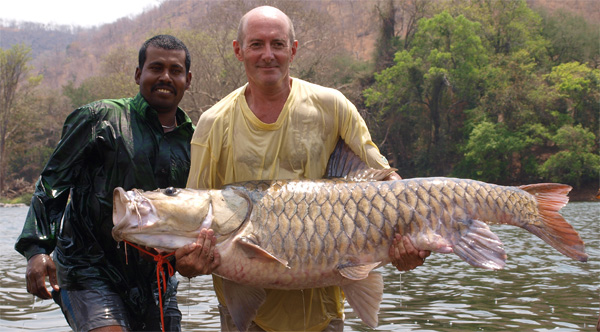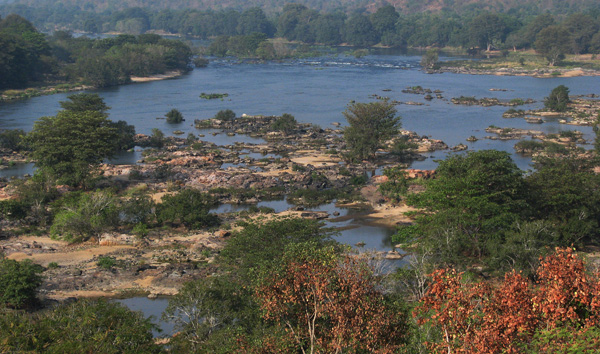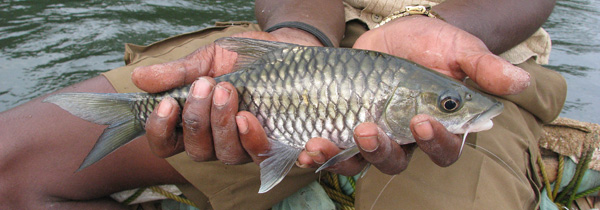Breaking News
The Mahseer Trust can confirm that following sampling in March and April 2014 in association with Coorg Wildlife Society (CWS) and Wildlife Association of South India (WASI), that they are now able to prove the existence of at least three different and distinct species of mahseer in the River Cauvery. Of these three species, only one is currently described to science (and can, thus be given a complete IUCN Red List protection status): Tor khudree, the ‘Deccan’ mahseer, which is the so-called blue-finned mahseer, native of the Muta-Mula catchment of Maharastra and a non-native fish in the River Cauvery.
We can surmise that the long-held belief (150 years plus) that there are two endemic (native) species of mahseer in the River Cauvery is probably true. We can also surmise that there may be more distinct species of mahseer in the river that are yet to be identified. We could, equally, posit the idea that all of these species of mahseer are as the result of artificial stocking policies, and that the endemic species are on the very brink of extinction before they have been described to science, hence the urgent need for more study.
Background
Due to some constraints on the size of one of the sampling teams and the inexperience of some members of that team (2014 study), the correct documentary proof was not obtained to match the samples of the three unknown species. One of these species is, quite probably, the so-called Humpbacked, or orange-finned mahseer, as we have matching records of the mitochondrial DNA sequence of a distinct species of mahseer from both Dubare in the Coorg district and Shivasamudram in Kollegal district of Karnataka.
This mahseer species is the iconic mahseer of worldwide fame. Due to the lack of a correct scientific identification of this species, it currently has no valid protection status, despite being the best-known mahseer species and a native of the River Cauvery. Individuals of this species are, and always have been, the largest mahseer known to man.

It is our belief that once correctly listed as a valid species, the Humpbacked mahseer of the River Cauvery is likely to be listed by IUCN in their Red List of Threatened Species as critically endangered, which means only one step away from the listing extinct in the wild. It will be the first mahseer species to hold the perilous critically endangered conservation status, but will also allow for the fish to gain a much higher profile as a species in dire need of protection.
In a scientific paper published during 2014, Adrian Pinder and Dr Rajeev Raghavan used historic angler catch data from the Cauvery Angling Camps to prove that this species is in decline. Catch records from CWS, photographic evidence collated by the Mahseer Trust and anecdotal reports from Coorg District attest to this proven decline, and there is no need to collect further data to illustrate this point. We speculate that this decline is probably due in the largest part to the pressure upon habitat caused by the introductions of the non-native and extremely prolific Tor khudree.

Project for 2015
The Mahseer Trust came up with a specific proposal to find sufficient samples of this severely endangered mahseer (in a two-week period during early February 2015) to allow it to gain a correct scientific identification and related conservation status. Our agreed proposal was to be led by Dr AJT Johnsingh (a native of Karnataka State, eminent field biologist and fervent supporter of mahseer conservation), and had the full backing of the Director of Fisheries for Karnataka State, Dr Ramakrishna.
As the top priority for this project, individuals of the humpbacked mahseer need to be captured, genetic material samples taken and the entire process recorded with photographs, measurements and meristic observations catalogued to accepted scientific norms to allow this mahseer to be given its rightful scientific status.
Mahseer Trust Press Officer, Steve Lockett, whose photographic speciality is field-based fish photography, in conjunction with his photographic assistant, Dr Ambily Nair and Mahseer Trust field researcher, Neethi Mahesh, will ensure that the recording process in 2015 is rigorous and allows for no error in the protocols needed to establish the identity of this mahseer.
Dr Rajeev Raghavan, Mahseer Trust Trustee and South Asia Chair of the IUCN Freshwater Fish Specialist Group will ensure the samples are collected in the proscribed manner and will co-ordinate the ongoing research into the taxonomy, and the genetic investigation that will be conducted by Dr Neelesh Dahanukar at Indian Institute of Science Education and Research, Pune, Maharastra.
As a secondary priority, the project needs to ascertain the natural recruitment status and abilities of this mahseer, to enable a rational assessment of the likely recovery possibilities of the species given new future protection status. Mahseer Trust Director, Adrian Pinder, who is Europe’s leading scientist in the field of juvenile fish identification and population assessment, will lead netting and recording teams during this part of the study process.

Timeframe
Planning for this project has been ongoing since the conclusion of the 2014 project in April last. Dr Ramakrishna gave his backing to this project in May 2014.
In June 2014, the Mahseer Trust approached WASI in appreciation of their near 50 year experience as custodians of large parts of the River Cauvery, to be a key logistical partner in this project.
Likewise, the Mahseer Trust asked WASI to use their excellent relationship with the Forest Department of Karnataka State in order to obtain the correct, legal permissions to enter Protected Areas of Forest to enable this project.
After long discussions and meetings about the permissions needed and the exact nature of the sample collection and recording that is vital to ensure this project is successful in establishing the status of this mahseer, we were allowed to visit a Protected Area and can confirm that mahseer are still plentiful. Permission to collect genetic materials was not allowed and, after further meetings between WASI and the Forest Dept of Karnataka State, the Mahseer Trust members decided to withdraw from the Protected Areas and concentrate on rivers with open access.
We hope to have more news from the survey on or around 22nd February.

Tor khudree Status
As described in the Breaking News section, Tor khudree is a non-native mahseer in the River Cauvery. It has been introduced to large areas of the river since the late 1970s and early 1980s and is, still, the subject of captive breeding programmes to further facilitate its spread.
We expect that thanks to our scientific survey work alongside detailed observations over a 10 year period and anecdotal feedback from many local sources, we will be able inform IUCN that the conservation status of Tor khudree should be moved to Least Concern. It is the belief of the Mahseer Trust that this mahseer species is highly productive, we can demonstrate that it has multiple spawning periods throughout the course of a year, and that it needs no help to maintain populations in the River Cauvery from artificial stocking and breeding programmes.
Plus
As part of this study, we may also expect that the status of the other two species of mahseer in the River Cauvery are correctly recorded and they are subsequently identified to science and given their due protection status. There is also the possibility that we discover more species or evolutionary distinct lineages of mahseer resident in the River Cauvery.











